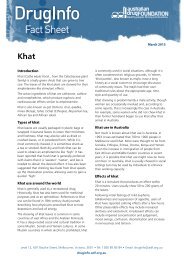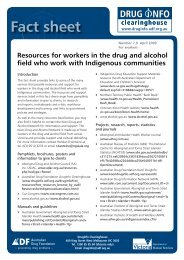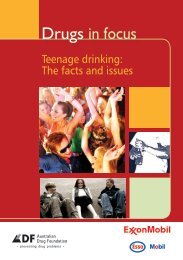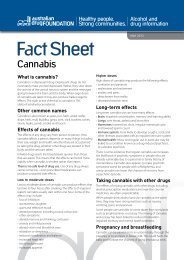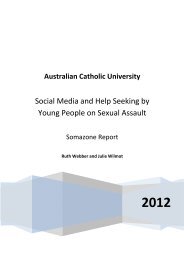Full report [PDF: 831KB](new window) - DrugInfo - Australian Drug ...
Full report [PDF: 831KB](new window) - DrugInfo - Australian Drug ...
Full report [PDF: 831KB](new window) - DrugInfo - Australian Drug ...
Create successful ePaper yourself
Turn your PDF publications into a flip-book with our unique Google optimized e-Paper software.
Figure 2: Major contributors to harm from alcohol consumption<br />
Supply factors<br />
Place<br />
• High numbers of outlets:<br />
– licensed premises<br />
– bottle shops and other liquor stores<br />
• Ready availability in outlets<br />
– longer opening hours<br />
– irresponsible serving<br />
– underage access<br />
• Drinking in public places condoned<br />
Promotion<br />
• Inappropriate advertising<br />
Price<br />
• Low prices<br />
• High strength<br />
Harmful alcohol<br />
consumption<br />
Alcohol is<br />
consumed at<br />
risky and high<br />
risk levels*<br />
Demand factors<br />
Population-wide<br />
• Wide acceptance of alcohol:<br />
– to celebrate<br />
– to commiserate<br />
– to relax<br />
• Social pressure<br />
– to join in<br />
Population specific<br />
• People from rural and regional areas<br />
• Young people<br />
• People with mental health problems<br />
• Homeless people<br />
Social harms<br />
• Public violence<br />
• Accident victims<br />
• Property damage<br />
• Family violence and breakdown<br />
• Decreased workplace productivity<br />
• Costs to the community of acute and chronic<br />
health care<br />
• Costs to the community of related crime and<br />
other social impacts<br />
Individual harms to users<br />
• Acute health risks, such as alcohol poisoning<br />
• Motor vehicle accidents<br />
• Falls and other injuries<br />
• Physical or sexual assault risk<br />
• Disrupted education and training<br />
• Unemployment<br />
• Chronic health risks, such as liver cirrhosis,<br />
cancer and irreversible brain damage<br />
• Premature death<br />
*Current <strong>Australian</strong> Alcohol Guidelines that define alcohol consumption risk are available<br />
from www.alcoholguidelines.gov.au. These are periodically revised and updated.<br />
Adapted from Dibley 2007.<br />
Based on these statistics, it would be easy to focus<br />
solely on young people or some other specific<br />
population groups. However, it is important to<br />
recognise the risks of harm from alcohol consumption<br />
across the entire population and respond with broad<br />
based strategies as well.<br />
Factors influencing harm<br />
from alcohol consumption<br />
The factors that contribute to harm from alcohol<br />
consumption are very complex. One way of thinking<br />
about it is to consider the “supply side” (the factors<br />
that result in alcohol being readily available to<br />
consumers) and the “demand side” (the factors<br />
that are more likely to draw people into patterns of<br />
harmful drinking). Figure 2 illustrates these broad<br />
factors and the harms that can result.<br />
Geographical location can clearly influence these<br />
factors. This influence will vary between locations and<br />
will potentially differ depending on the prevailing<br />
culture regarding alcohol consumption.<br />
Supply side factors in rural communities<br />
There are major strategies designed to control or<br />
manage the supply of alcohol at a national and/or<br />
statewide level. This includes measures such as:<br />
◗◗ border controls, which limit what alcohol gets into<br />
the country<br />
◗◗ high level policies, laws and regulations regarding<br />
availability, strength and advertising<br />
◗◗ taxes and excise, which impact on price (Loxley et<br />
al. 2005)<br />
◗◗ social marketing and media campaigns aimed at<br />
promoting responsible use.<br />
Issues Paper | No. 4 | February 2008<br />
3


 - DrugInfo - Australian Drug ...](https://img.yumpu.com/30654388/7/500x640/full-report-pdf-831kbnew-window-druginfo-australian-drug-.jpg)
